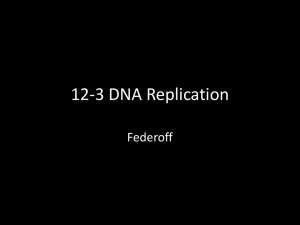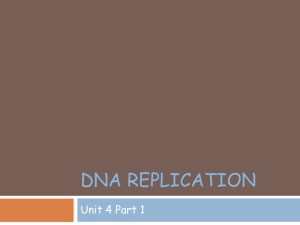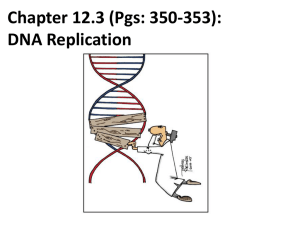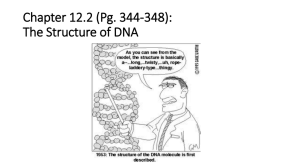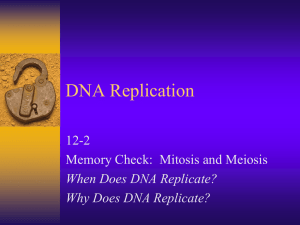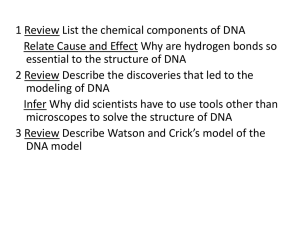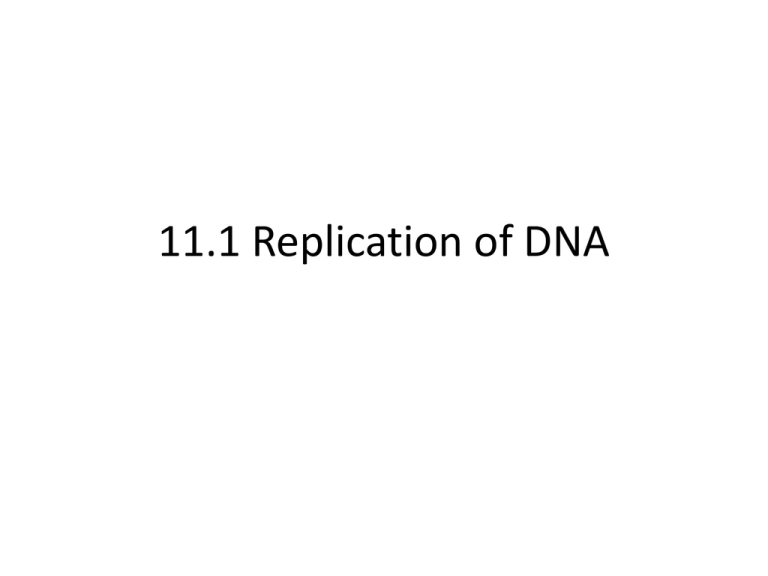
11.1 Replication of DNA
Learning Objectives
• What happens during DNA replication?
• How is a new polynucleotide strand formed?
• Why is DNA replication known as ‘semiconservative’?
Putting What We’ve Learnt So Far In To
Context...
8.1 Structure of DNA
We focussed mainly on
the chemical structure
of DNA as a whole. DNA
is a double-stranded
polymer, but what
makes it up?
8.3 DNA & Chromosomes
In this lesson, we found out how DNA is
actually stored. How is it possible to fit
such a vast amount of information into
something as small as a cell?
8.2 The Triplet Code
Here, we introduced
RNA. We found out that
the code in RNA is
actually converted to
RNA before protein
synthesis.
This Lesson...
• For the moment, forget about chromosomes and
triplet codes and RNA.
• Get back to basics and think about the basic
structure of DNA....
phosphate
phosphodiester
bond
base
deoxyribose
Good. Now Cell Division...
What processes allowed you to become the 75 or so TRILLION
cells that you are?
MITOSIS
What process produces the sex cells within your body?
MEIOSIS
Cell Division...
When cell division occurs, a cell will basically split into two
identical cells.
Whatever was in the original cell has to be DUPLICATED and
then packaged into two new cells!
!!!
Therefore, the entire cell contents have to be doubled before a
cell can divide.
And the most important content of all, is the DNA in the
nucleus.
This leads us to DNA Replication........
Replicating DNA
Possibly the most perfect process in
the universe, for it will happen inside
you nearly a quadrillion times,
flawlessly.
Replicating DNA
For years after the structure of DNA was discovered, scientists
came up with countless theories on how the molecule
reproduced itself.
Today, the accepted method is the...
SEMI-CONSERVATIVE REPLICATION OF DNA
This method of replication requires 4 conditions to be met:
1. A pool of the four types of nucleotides must be present.
2. Both strands of the DNA being copied, act as a template.
3. The enzyme, DNA Polymerase must be present.
4. A source of energy (ATP) is required to drive the
process.
Semi-Conservative Replication
Step 1: An enzyme called DNA Helicase breaks the hydrogen bonds
between the bases of the two strands of DNA.
DNA
Helicase
Note:
Meet
thecompletely
section of separate.
DNA beingThey stay linked
The two strands
don’t
at the top, because DNAreplicated.
helicase has an ‘unzipping’ action.
Semi-Conservative Replication
After DNA
Helicase...
Semi-Conservative Replication
Step 2: DNA helicase completes the splitting of the strand, and as it is
doing this, free nucleotides start to be attracted to their complementary
bases on the templates.
Semi-Conservative Replication
Pool of free nucleotides
Key Point:
Although a free nucleotide is
attracted to its
complementary base on the
template....
.... it cannot join until it is
activated by energy.
This energy is supplied by
ATP.
ATP!
ADP
Semi-Conservative Replication
Step 3: Once the nucleotides are in position, phosphodiester bonds are
formed between their phosphates and deoxyribose sugars. This is done by
the enzyme DNA polymerase.
DNA Polymerase
links the
nucleotides
Semi-Conservative Replication
Step 4: Two identical strands have now been formed! They are exact copies
of the strand that we started off with.
You can now see why the process is called semi-conservative. Half of the
original molecule is conserved, and the other half is newly synthesised!
In words...
1. The enzyme DNA Helicase breaks the hydrogen bonds
between the bases of the two strands.
2. The double helix separates into its two strands.
3. Each exposed strand now acts like a template.
4. Complementary free nucleotides are attracted to the
exposed bases on the strands.
5. Energy (ATP) is required to activate the free nucleotides.
6. Once the nucleotides are in place, their ‘backbone’ is
joined together by DNA Polymerase.
7. Two new DNA strands are produced.
8. Each of these contains half of the original strand, and
half a new strand.

